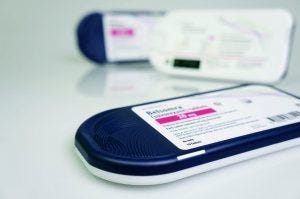Voices of Biotech
Podcast: MilliporeSigma says education vital to creating unbreakable chain for sustainability
MilliporeSigma discusses the importance of people, education, and the benefits of embracing discomfort to bolster sustainability efforts.
April 19, 2018
 The future success of biopharmaceutical businesses will depend at least partly on their ability to create meaningful brand experiences from the start of a drug program. By “brand,” I don’t mean logos and taglines. I’m talking about meaningfully unique experiences that directly affect clinical and patient needs — specifically, to address the growing demand for self-administered injectable therapeutics.
The future success of biopharmaceutical businesses will depend at least partly on their ability to create meaningful brand experiences from the start of a drug program. By “brand,” I don’t mean logos and taglines. I’m talking about meaningfully unique experiences that directly affect clinical and patient needs — specifically, to address the growing demand for self-administered injectable therapeutics.
Whether you are a biosimilar developer trying to carve out differentiated value or a market leader looking at your patent protection in the rearview mirror, brand experience can improve your ability to capture market share effectively and deliver your life-enhancing molecule to the people who need it. After all, when a drug is subject to clinical parity among its competitors, its value comes from factors that increase the likelihood of each patient recipient’s administrating that therapy the right way, at the right time, every time.
Consumer experience and patient adherence are growing concerns. Consider these factors: One-third of all new drug approvals are biologics. An aging population needs solutions designed for universal access. Payers continue to push for out-of-clinic solutions. Consumers continue to expect that no disease should crimp their lifestyles. The result is a need for end-user, design-driven solutions that allow people to do the things they need to do without compromising safety or efficacy.
Extras Aren’t Extraneous
A major opportunity to address patient experience begins with a holistic approach to product development, research and development, marketing, and branding. The traditional tug-of-war between development and marketing tends to deprioritize the user-experience “extras” such as ease of use, ergonomics, and intuitiveness. Accordingly, once the celebration of product approval and launch are over, sponsors often are left with generic packaging solutions that could fall short on consumer usability (making them a potential risk to clinical outcomes) and thus fail to reach their full potential as ownable assets.
Pharmaceutical companies have benefited from brand-design thinking. Consider the ergonomics, navigability, identification, and usability of Pfizer’s Z-pak and Merck’s Zepatier blister packs. Intangibles such as relevance and resonance bring to mind GSK’s Advair inhaler and Merck’s Belsomra stress-free blister (pictured above). The opportunity for injectable biologics could be even more game-changing than those familiar successes because of the participatory nature of their self-administration.
Case Study: This type of thinking about end-user experience went into the development of kaléo’s Auvi-Q epinephrine autoinjector. As stated on the product website, the company’s mission is to “provide demonstrably superior medical products that empower” patients and caregivers to “take control in potentially life-threatening situations.” Realization of that vision comes from medical device expertise: “Each kaléo product combines an established drug with an innovative delivery platform” for both cost effectiveness and superiority over the standard of care.
Compare the brand experience between that and Mylan’s EpiPen injectors in terms of consumer usability. The former provides a perfect blend of user education, instruction, motivation, and inspiration. The latter meets the bar satisfactorily, but parents of children with allergies vastly prefer kaléo’s alternative by nearly four to one (1).
For companies aspiring to offer safe, efficacious biomolecules through delivery packages that eliminate all physical, perceptual, and motivational barriers, the answer is to plan ahead. Even during drug-substance development, you should be thinking of a drug-delivery system or package that not only makes it easy for consumers to self-administer (winning fans from clinical and payor audiences alike), but that also is made with patients’ experiences in mind.
Think “Universal” for Product Design
To begin with, you can practice the principles of universal design: equitability, flexibility, simplicity, perception, error tolerance, ease of use, and appropriateness for use (2). Eliminate unnecessary complexity. Be consistent with user expectations and intuition. And arrange information consistent with its importance.
Then, as you aim for more patient-centric and brand-differentiating experiences, you can aspire to solutions that speak to people’s whole selves with design that emotes, motivates, and empowers. If I am forced to live with a chronic disease, then I should get to choose the therapy that doesn’t remind me of that fact every time I use it. It doesn’t have to be fun. But if your design makes the experience less unpleasant in some way than it would be otherwise, patients will pay you back with adherence and loyalty. Your investors will be gratified when no competitor can easily copy the value you have created.
References
1 Camargo CA, et al. Auvi-Q Versus EpiPen: Preferences of Adults, Caregivers, and Children. J. Allergy Clin. Immunol. www.jaci-inpractice.org/article/S2213-2198(13)00125-6/fulltext.
2 The 7 Principles. Centre for Excellence in Universal Design: Dublin, Ireland; http://universaldesign.ie/What-is-Universal-Design/The-7-Principles.
Brian McDonagh is a strategy director for CBX, 520 Nicollet Mall, Suite 1000, Minneapolis, MN 55402; 1-763-390-1100 , fax 1-763-3901111; [email protected]. In his career, McDonagh has worked with such companies as Kimberly-Clark, Merck, Medtronic, and PepsiCo.
You May Also Like